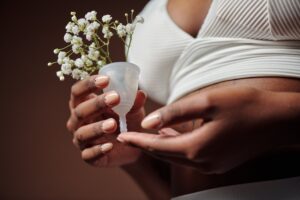Written by Pooja Bista
We live in a society where taboos surrounding sexual and menstrual health imposed on our vulva are like Pandora’s Box. Neither can we talk about it nor can we touch it– reinforcing the patriarchal concept of “purity”, “the idea of protecting hymen at all costs”, and “saving it” for marriage.
Individuals with vulva are accustomed to thinking that touching and peeking at their genitals is inappropriate such that taking ownership and autonomy of our own body and pleasure seems a whimsical story. The way we are constantly lectured about our bodies has structured our concepts and attitudes over the years, which is still ambiguous.
I joined Clubhouse when it was first launched on Android phones, wherein groups talked openly about menstruation and menstrual cups. I was also in the same room twice, where people shared and listened to one another’s experiences with menstrual cups. Being a newbie to menstrual cups while at the same time advocating their use, I felt proud and excited every time I shared or heard people talking about it.
There were a lot of people wanting to use the menstrual cup, but the only hindrance between them and the menstrual cup was fear— fear of the unknown.

The vagina, a part of the vulva, is a mystery for many of us. And something like a menstrual cup that goes inside the vagina can surely create anxiety and confusion among menstruating individuals.
Many might not know, but a menstrual cup is a small funnel or bell-shaped menstrual product which is foldable, reusable, eco-friendly and cost-effective. It is made from silicone, rubber or latex that collects or absorbs menstrual blood when inserted into the vagina. It is also available in different sizes and colours which can be worn for up to 12 hours and stay with you for at least five to ten years depending upon your product. In Nepal, the menstrual cup was first introduced in 2014 by Putali Nepal and now, all thanks to the internet, you can also find a lot of information about it online. Do check out if you’re planning to switch. On a side note, the consumption of plastic can be reduced if you are trying to switch to the greener side.
Menstruation, a long taboo still prevalent in Nepal, can be taken as a precedent. The constant phenomenon of humiliation, guilt and the need to keep one’s bleeding, a natural process, as obscured as possible has seized our freedom to scrutinize ourselves as well. Be it exploring menstrual products like tampons and menstrual cups over conventionally used menstrual pads or cloth pads.
So, where does this fear of using cups come from? And how do we win over our fear and accept it? I think there are various reasons for fear to exist among us. For instance, lack of information and education on reproductive health, being unable to break the cultural oppression of using pads because of uncertainty, lack of accessibility, expenses, proper toilet facilities/services, and other resources. Also, the capitalists’ menstrual pads industry in Nepal gives us fewer options to explore other menstrual products.
Similarly, the price ranges of pads according to the brands and quality such as Rs. 45 for a packet of the pad with no wings, less absorbent, no fragrance and less marketing whereas Rs. 80 for a packet of pads with everything mentioned above. Comparing the prices of pads and cups, the initial investment in cups looks heavier but it lasts up to five to 10 years depending on the product you buy.
The very first idea of inserting foreign objects inside the vagina during the period feels scary and a sense of discomfort. Many participants in the clubhouse asked common questions like what if the cup gets lost inside or what if it travels beyond the uterus? Undoubtedly, the fear of uncertainty comes from within but also because of the traditional knowledge that is passed from generation to generation without anyone questioning. If questioned especially by young girls or women, they are shut down in the name of lack of obedience and lack of respect for elders. Nevertheless, these questions were no surprise to me because of my recent work in Achham, where women in their late twenties and early thirties had similar queries. Under the Rato Baltin Project that started in 2017, we encouraged menstruating individuals to use menstrual cups and also taught them how to use them.
Considering the fact that these queries were raised in Clubhouse: a privileged social platform — I assumed they were more aware of it. But after reflecting on my assumptions for several days, I found a common thread in it, i.e. we are brought up in a patriarchal society, and the schooling system of knowing reproductive organs or menstruation is limited to our health books only.
Not to mention, we still teach them with ‘shame’ and ‘silence’, without having many discussions like in other health chapters. Nonetheless, the education and awareness in urban areas are moderately high, and menstruating individuals in the urban areas also have a high acceptance of switching menstrual products. And interestingly, among the school-going girls, acceptance of this new product is the same in every area when taught about it properly.
Furthermore, it raises another question on the relationship between patients and gynaecologists in Nepal. Or how often do we have access to medical facilities/services if somehow the cup gets lost inside? Deeply rooted misconceptions, misunderstandings, or no understanding at all regarding women’s health, those of menstruating individuals and their bodies have fueled the fear of using a menstrual cup.
I remember it was back in 2017 when I first saw an advertisement for the menstrual cup on Facebook. I browsed the products’ website time and again as it grabbed my attention for being a vegan product. Had I not seen it in the ad, I would never have manifested it. Likewise, I got my cup in 2018 as a motivation but little did I know it would be in my cupboard as a precious yet hidden gift for more than three years. And interestingly, I read the instructions given on that box 100s times in between. Did I tell you about the counts of YouTube videos, articles and conversations among cup users? On lazy days of trying, I’d just sigh, drained and say, “screw it” and give it up.
Yet, using a menstrual cup was a far-fetched dream for me because boiling it in a kitchen where the gas is the only option scared me. With courage and wit, I boiled and tried to insert it in the lockdown time and failed. Finally, the day came in April 2020 when my vagina welcomed the cup during my work call to Achham.
I couldn’t agree more with the fact that choosing menstrual products is a personal choice and a privilege. But if you hold the privilege, then let these pervasive cultural messages be shattered.
In recent months, I have been closer to my period health than before. Struggling with loving my body for several years and later using a menstrual cup has deepened my friendship with my body. For a long time, the internet has played a significant role for me in understanding the need for self-love, body image and feeling that I am not the only one feeling certain emotions.
With the mindful approach or say social media literacy of verifying ideas and information from different sources, I have experienced the positive side of the internet.
I am gradually being comfortable and closer with my reproductive organs, which have welcomed the whole new alternative universe inside me. Putting my fingers inside and outside to insert, fix, and remove my cup has liberated my relationship with the so-called taboo part of a woman’s body. Every time when I dispose of my period blood, I see its colour and volume, which has now become a communication tool between my internal system and the whole of me. I would say, it’s not easy to be who you are with your body and it takes hell lots of effort and courage to get there.
There have definitely been ups and downs ever since I started writing and publishing about menstruation in newspapers and on my own blogs as part of my advocacy. There are days when I am encouraged and appreciated for sharing collective feelings. And some days where my advocacy on the topic is discouraged. One of my articles on menstruation got reported and blocked on my blog which is still inactive for the past two years (on and off) and counting. The blog was reported by people due to an artistic image of the vulva that I had put as a cover image to which Facebook removed it by stating that it incited ‘violence of community guidelines’. As I love talking about this issue anytime, my knowledge has been testified with political, and international current affairs questions such that I have been told not to actively advocate for menstruation and referred to as a ‘woke woman’. However, such comments do not stop me and I continue to talk about menstruation and the stigma attached to it in a heteronormative-patriarchal society that considers something as natural as period as “impure”.
Time and again, I stand by this quote of Rabbi Hillel who famously said, “If I am not for myself, who will be for me? If I am only for myself, what am I? If not now, when?” – Signing off!
“ If I am not for myself, who will be for me? If I am only for myself, what am I? If not now, when?”
If I am not for myself, who will be for me? If I am only for myself, what am I? If not now, when?”
– Pooja Bista is an explorer, seeker and practitioner
Find Pooja on Instagram.
